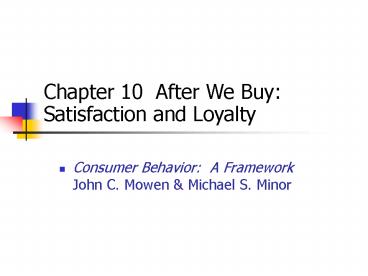Consumer Behavior: A Framework John C' Mowen - PowerPoint PPT Presentation
1 / 28
Title:
Consumer Behavior: A Framework John C' Mowen
Description:
Consumer Complaint Behavior. Common complaint behaviors: Do ... Complaint Behavior Is. Likely to Increase When: The level of consumer dissatisfaction increases ... – PowerPoint PPT presentation
Number of Views:1087
Avg rating:3.0/5.0
Title: Consumer Behavior: A Framework John C' Mowen
1
Chapter 10 After We Buy Satisfaction and
Loyalty
- Consumer Behavior A FrameworkJohn C. Mowen
Michael S. Minor
2
Key Concepts
- Satisfaction and dissatisfaction
- Brand expectations
- Equity and satisfaction
- Expectation confirmation
- Why consumers complain
- How consumers complain
- Factors that influence complaining
- Product disposal
- Ensuring satisfaction
- Brand loyalty
3
Consumer Postacquisition Process
Product Acquisition
Product Usage/Consumption
Product Satisfaction/Dissatisfaction
Consumer Complaint Behavior
Brand Loyalty
Product Disposition
4
A Consumption Experience. . .
- . . . is the cognitions and feelings the
consumer experiences during the use of a product
or service
5
Product use . . .
- . . . involves the actions and experiences that
take place in the time period in which a consumer
is directly experiencing a good or service
6
Assessing Product Usage - Three Methods
- Consumption Frequency
- Consumption Amount
- Consumption Purpose
7
Mood States and the Consumption Experience
- Moods are temporary positive or negative
affective states that may affect the consumption
experience.
8
Developing Postacquisition Satisfaction or
Dissatisfaction
- I. Consumer satisfaction is the overall attitude
consumers have toward a good or service after
they have acquired and used it.
9
Consumer Satisfaction/Dissatisfaction
Product Usage/ Consumption
II. Product Performance/ Quality Evaluations
III. Expectancy Confirmation/ Disconfirmation
Expectations Of Product Performance/ Quality
V. Attributions Of Cause
VI. Emotional Response
IV. Evaluations Of Exchange Equity
I. Consumer Satisfaction/ Dissatisfaction
10
II. Evaluating Product Performance and Quality
- Product quality is customers overall evaluation
of the excellence of the performance of the good
or service.
11
Seven Basic Dimensions of Quality
- Performance
- Employee Interactions
- Reliability
- Durability
- Timeliness and convenience
- Aesthetics
- Brand Equity
12
Five Approaches to Customer Satisfaction/Dissatisf
action
- Expectancy Disconfirmation
- Equity Theory
- Attribution Theory
- Actual Performance
- Experientially Based Affective Feelings
13
III. Expectancy Disconfirmation
- Performance expectations are compared to actual
product performance. - Performance below expectations
- Emotional dissatisfaction
- Performance above expectations
- Emotional satisfaction
- Performance matches expectations
- Expectancy confirmation
14
IV. Equity Theory
- People analyze the ratio of their outcomes and
inputs to the outcomes and inputs of the other
party in the exchange
15
V. Attribution Theory
- Attribute blame for product failure to
- Product, service, or supplier
- Chance factors
- Own behavior.
16
Actual Product. . .
- . . . performance influences consumer
satisfaction independently of expectations,
equity, and attributions. - Even if a consumer expected the product to
perform badly, they still feel dissatisfied when
it does
17
VI. Affective Feelings. . .
- Level of consumer satisfaction may be influenced
by the positive/negative feelings that consumers
associate with the product/ service after its
purchase and use.
18
Measuring Satisfaction
- Likert agree/disagree scales 1-5
- Rating different aspects of the service 1-5
- Bias toward higher satisfaction
- Satisfaction often does not mean loyalty
19
Consumer Complaint Behavior
- Common complaint behaviors
- Do nothing
- Deal with the retailer in some manner
- Avoid the retailer or brand
- Persuade friends and family to avoid the retailer
or brand. - Take overt action with third party
- Boycott the firm or organization.
- Create an alternative organization to provide the
good or service
20
Major Reasons Consumers Complain
- To recover an economic loss by getting an
exchange or refund - To rebuild a consumer's self-image
21
Complaint Behavior Is Likely to Increase When
- The level of consumer dissatisfaction increases
- The attitude of the consumer toward complaining
becomes more positive - The amount of benefit to be gained from
complaining increases - The firm is blamed for the problem
- The product is important to the consumer
- The resources available to the consumer for
complaining increases
22
Product Disposition . . .
- . . . refers to what consumers do with a product
after they have completed their use of it. - Three Dispositional Strategies
- Keep It
- Get Rid of It Permanently
- Get Rid of It Temporarily
23
Brand loyalty
- Positive attitude towards a brand
- Commitment to it
- Intention to continue purchasing
24
Behavioral Measures of Loyalty
- Proportion of purchases method
- Undivided Loyalty AAAAAAAA
- Occasional switch AABAAACAADA
- Switch loyalty AAAAABBBBB
- Divided loyalty AAABBAABBB
- Brand indifference ABDCBACD
25
Attitudinal Measures of Brand Loyalty
- Repeat Purchase Behavior, vs.
- Brand Loyalty
- The Difference is -
- Brand Commitment
26
Identifying Brand-Loyal Consumers
- Brand loyalty is product-specific.
- There are no demographic or psychological
characteristics of the brand-loyal. - Sales promotions can inhibit brand loyalty.
- Quality of the product and use of advertising are
key to building brand loyalty.
27
Comparing Satisfactionand Loyalty
- Satisfaction is an unreliable indicator of
loyalty. - Variety seeking, loyalty to multiple brands, and
switching incentives are obstacles to loyalty. - Expect greater emphasis on loyalty over
satisfaction
28
Managerial Implications
- Positioning
- Environmental
- Market Research
- Marketing Mix
- Segmentation































